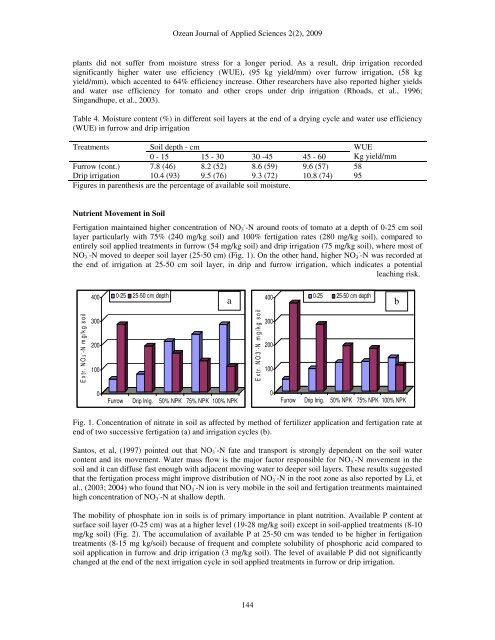Download Complate Issue - Ozean Publications
Download Complate Issue - Ozean Publications
Download Complate Issue - Ozean Publications
Create successful ePaper yourself
Turn your PDF publications into a flip-book with our unique Google optimized e-Paper software.
<strong>Ozean</strong> Journal of Applied Sciences 2(2), 2009plants did not suffer from moisture stress for a longer period. As a result, drip irrigation recordedsignificantly higher water use efficiency (WUE), (95 kg yield/mm) over furrow irrigation, (58 kgyield/mm), which accented to 64% efficiency increase. Other researchers have also reported higher yieldsand water use efficiency for tomato and other crops under drip irrigation (Rhoads, et al., 1996;Singandhupe, et al., 2003).Table 4. Moisture content (%) in different soil layers at the end of a drying cycle and water use efficiency(WUE) in furrow and drip irrigationTreatments Soil depth - cm WUE0 - 15 15 - 30 30 -45 45 - 60 Kg yield/mmFurrow (cont.) 7.8 (46) 8.2 (52) 8.6 (59) 9.6 (57) 58Drip irrigation 10.4 (93) 9.5 (76) 9.3 (72) 10.8 (74) 95Figures in parenthesis are the percentage of available soil moisture.Nutrient Movement in SoilFertigation maintained higher concentration of NO 3 - -N around roots of tomato at a depth of 0-25 cm soillayer particularly with 75% (240 mg/kg soil) and 100% fertigation rates (280 mg/kg soil), compared toentirely soil applied treatments in furrow (54 mg/kg soil) and drip irrigation (75 mg/kg soil), where most ofNO 3 - -N moved to deeper soil layer (25-50 cm) (Fig. 1). On the other hand, higher NO 3 - -N was recorded atthe end of irrigation at 25-50 cm soil layer, in drip and furrow irrigation, which indicates a potentialleaching risk.4000-25 25-50 cm deptha4000-25 25-50 cm depthbE x tr. N O 3 - -N m g/k g s oil300200100E x t r. N O 3 - -N m g / k g s o il3002001000Furrow Drip Irrig. 50% NPK 75% NPK 100% NPK0Furrow Drip Irrig. 50% NPK 75% NPK 100% NPKFig. 1. Concentration of nitrate in soil as affected by method of fertilizer application and fertigation rate atend of two successive fertigation (a) and irrigation cycles (b).Santos, et al, (1997) pointed out that NO 3 - -N fate and transport is strongly dependent on the soil watercontent and its movement. Water mass flow is the major factor responsible for NO 3 - -N movement in thesoil and it can diffuse fast enough with adjacent moving water to deeper soil layers. These results suggestedthat the fertigation process might improve distribution of NO 3 - -N in the root zone as also reported by Li, etal., (2003; 2004) who found that NO 3 - -N ion is very mobile in the soil and fertigation treatments maintainedhigh concentration of NO 3 - -N at shallow depth.The mobility of phosphate ion in soils is of primary importance in plant nutrition. Available P content atsurface soil layer (0-25 cm) was at a higher level (19-28 mg/kg soil) except in soil-applied treatments (8-10mg/kg soil) (Fig. 2). The accumulation of available P at 25-50 cm was tended to be higher in fertigationtreatments (8-15 mg kg/soil) because of frequent and complete solubility of phosphoric acid compared tosoil application in furrow and drip irrigation (3 mg/kg soil). The level of available P did not significantlychanged at the end of the next irrigation cycle in soil applied treatments in furrow or drip irrigation.144
















